Douglas House
Houses within 15km of this house
Displaying 105 houses.
Houses within 15km of Douglas House
Displaying 105 houses.
| House name | Description | |
|---|---|---|
| Aghern/Ahern House | Brabazon Esq was resident in the 1770s and 1780s. The home of Spotswood Bowles in the first half of the 19th century. The buildings were valued at £47+ in the early 1850s and held from the representatives of William Beamish. Spotswood died in 1864 and was succeeded by his son George who was in turn succeeded by his nephew Spotswood in 1886. Relatives of the Bowles owned this property until the 1970s. In 1942 the Irish Tourist Association Survey mentions the ruins of Aghern Castle in the grounds of Mrs. Spotswood Bowles property. Aghern was uninhabited for a time but has recently been restored. |

|
| Castle Hyde | A late 18th century house, which was the home of the Hyde family. In 1786 Wilson describes it as "a beautiful house, magnificent demesne, highly cultivated, the seat of Arthur Hyde". At the time of the sale of Castle Hyde in 1851 the house was occupied by Spencer Cosby Price, the brother-in-law of John Hyde. The house was valued at £115. Castle Hyde was bought by John Sadleir MP in trust [for Vincent Scully]. Major Chichester was the tenant from year to year in 1861. John Wrixon Becher, second son of Sir William Wrixon Becher of Ballygiblin, county Cork, subsequently lived at Castle Hyde. in the 1870s John R. Wrixon of Castle Hyde is recorded as the owner of 1,263 acres in county Cork. He was resident in 1906 when the buildings were valued at £96. The Irish Tourist Association Survey of 1942 indicated that the house was then "occupied by the military". Castle Hyde is now the home of dancer, Michael Flatley. |

|
| Kilshannig | This house was built for Abraham Devonsher, a Cork banker and Member of Parliament, in the 1760s. It remained the home of the Devonsher family until sold to Edward Roche, father of the 1st Earl of Fermoy, pre 1837. Lewis records it as the winter residence of the Roche family. At the time of Griffith's Valuation it was occupied by James Kelly of Cahircon, son-in-law of Edward Roche, and valued at £58+. In 1943 the Irish Tourist Association Survey mentioned that it was the home of the McVeigh family. The Sardinian architect, Davis Ducart, designed this house and according to the Irish Georgian Society it is considered one of the very finest Palladian houses in Ireland. The Society is currently supporting the restoration of parts of this house. see http://www.igs.ie/Programmes/Conservation-Grants/Kilshannig.aspx |

|
| Convamore Upper | J. Delany was the proprietor of Upper Convamore in 1837. George Crofts occupied the house in the early 1850s. He held it from the Reverend G. Atkins Collins and it was valued at £16. The property was later bought by the Reverend Maurice Collis who sold it to the Earl of Listowel. Unoccupied for much of the 20th century it was demolished in 2000. | |
| Convamore | This property was sold by the Bailey family to the Hares in the late 18th century. William Hare, 1st Earl of Listowel, built a new house beside the River Blackwater in the early 19th century. He was residing at Convamore in 1814. At the time of Griffith's Valuation the buildings were valued at £100 and the property was held by the Earl from the representatives of D. Callaghan. Callaghan's interest was advertised for sale in July 1853. It was still the Earl's seat in 1894. The house was burnt during the War of Independence in 1921 and is now a ruin. |

|
| Ballykeating | A house probably built in the mid 19th century, occupied by John Grove Annesley who held the property from his father General Annesley. It was valued at £14 at the time of Griffith's Valuation. Sold to the Callaghans in the mid 1890s. The Callaghans continued to own the property until the late 1970s. A property much associated with horse racing and hunting. Buildings are still extant at the site. | |
| Lisnagoorneen | Hajba writes that Thomas Franks, a nephew of Thomas Franks of Ballymagooly, occupied this house at the end of the 18th century. He married Margaret Maunsell of Ballybrood, county Limerick. They and their son were murdered by Whiteboys in 1823. A new house was built by George Foster Delaney in the 1830s and he was succeeded by his nephew George Johnson who occupied the house at the time of Griffith's Valuation. It was valued at £17 and held from the representatives of G.B. Lowe. The Johnson remained in possession until the early 20th century leasing the house to Major Mansergh among others. In 1942 the Irish Tourist Association survey noted that the Major had owned a famous horse called Lord Cunningham and that Lisnagoorneen house was then occupied by his nephew. |

|
| Ballyenahan | A house on the Hyde estate inhabited by the Welsh, Kearney, Spratt, Greene and Barry families in the late 18th and 19th centuries. Wilson, writing in 1786, refers to it as the seat of Mr. Walsh. Eliza Greene was the occupant at the time of Griffith's Valuation when the buildings were valued at £18. The Barrys owned this house until the late 20th century. |
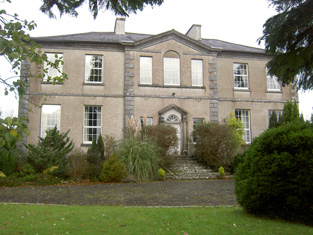
|
| Ballyclogh [Ballyclough] | This property was inherited by the Barrys through marriage with a member of the Purdon family. Parts of this house may have dated from the 17th century. Lewis writes of "a handsome mansion in the Elizabethan style". Additions were made in the 19th century. At the time of Griffith's Valuation it was valued at £34 and held by James Barry in fee. The house was burnt in the 1920s. The north wing survived, built 1904. In 1944 the Irish Tourist Association survey noted that Ballyclough was the birthplace of Sir Redmond Barry, "prominent in public life in the state of Victoria, Australia". It was restored and is still a residence. |
![Photo of Ballyclogh [Ballyclough]](https://landedestates.ie/storage/img/orig/1568.jpg)
|
| Airhill | The home of the Green family for over two centuries, occupied by Colonel H. G. Barry in 1814 and by James Greene at the time of Griffith's Valuation. James Greene held the property from Francis Wyse. The buildings were valued at £20. This house is still a family home. | |
| Sandville | This house valued at £13 was occupied by Mary Sullivan and held from - Roberts at the time of Griffith's Valuation. Hajba writes that it was occupied by Mrs Ellen Punch in 1910. It was bought by the racing trio of Sangster, Pigott and O'Brien in the late 1960s. The house was demolished and the property became a stud farm. | |
| Downing | This was the home of the Hendley family in the 19th century. Robert Hendley was the occupier in 1814 and Arthur Henly in the early 1850s. Arthur Henly held the property in fee and the buildings were valued at £9.5 shillings. | |
| Woodville | Woodville was occupied by the Reverend William Berkley in 1814 and in 1837 by Mrs Gibbons. Anne Gibbings was resident in the 1850s [widow of Bartholomew Gibbings of Gibbings Grove]. She held the property from Martha Jaunsey and the buildings were valued at £17.15 shillings. Her fourth son Robert Gibbings is described as "of Woodville" in Burke's Landed Gentry. A note on the sale rental of 1862 records the purchase of Lot 1 Woodville by Mr Starkey [Dr William Starkey]. The house remained in the possession of the Starkey family until the early 20th century. |
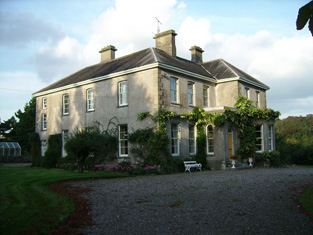
|
| Renny | This house, overlooking the River Blackwater, may have been part of the Widenham estate which passed to the Smyths. The site had earlier associations with the poet Edmund Spenser. Wilson, writing in 1786, refers to "Rinny, the seat of Mr. Nagle, which was formerly part of the estate of the immortal Spenser". In 1814 the Reverend C.P. Wallis was the occupant. At the time of Griffith's Valuation the house was occupied by Henry Smith who held the property in fee, the buildings were valued at £23. Henry Smyth advertised the house and 541 acres for sale in May 1851, all it required at that time was a "small outlay in paint and paper to make it at once fit for occupation". In 1885 Walford noted Renny as the seat of John Blackburne. Hajba writes that the last occupant was Captain [Pepper] Roberts. The Earl of Listowel demolished the house following the Captain's death in 1900 though many of the buildings shown on the 1st edition Ordnance Survey map had already disappeared by then. | |
| Gurteen | Home of the Campion family in the first half of the 19th century held from the Earls of Listowel. Luke Campion was resident in 1837 and Lewis writes that it had "been greatly enlarged and improved". Mrs Mary Campion was resident in the early 1850s. The buildings were valued at £13.15 shillings. Later occupants were stewards to the Earl. The house was demolished in the early 20th century. | |
| Cregg South [Avonmore] | The Phipps "of Cregg" are recorded in "Burke's Irish Family Records" from the early 18th century. By the time of Griffith's Valuation the house in Cregg South valued at £22 was occupied by John Carey who held it from John Phipps. On the 25-inch Ordnance Survey map of the 1890s the house at this site is labelled Avonmore. A house is still extant there. | |
| Templenoe | Hajba writes that this house, on the banks of the River Blackwater, was built in 1761 by the Hydes of Castle Hyde. William Hyde (died 1790) of Templenoe was the son of John Hyde of Creg Castle and grandson of Arthur Hyde of Castle Hyde. He married Catherine Lane. William Lane Hyde was resident in 1837 and at the time of Griffith's Valuation. He held the property valued at £20 from John Phipps. His estate of 584 acres was advertised for sale in July 1850. The present Templenoe House was the residence of the Mounteagles in the latter half of the 20th century. |
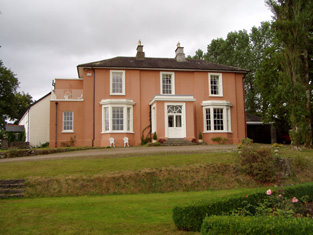
|
| Cregg Castle | Built by the Hyde family and occupied by John Hyde, a younger son of Arthur Hyde of Castle Hyde, in the mid 18th century. Wilson refers to the residence of John Hyde, "near the ruins of Creg Castle" in 1786. By 1810 Cregg Castle was occupied by Colonel William Stewart from Fort Stewart, county Donegal who had married Anne Hyde. The Colonel was the proprietor in 1837 and Mrs Anne Stewart was still resident in the early 1850s. Her nephew John came to live at the house following the sale of Castle Hyde in 1851 and following his death in 1885 it was leased to various persons. It is still extant. |

|
| Woodfort | George Massy occupied this house, which he held from the Reverend Samuel Adams, in the early 1850s. It was valued at £20. The home of the Magniers at the beginning of the 21st century. |

|
| Creggolympry | Henry Adams occupied a house at Creg, Fermoy in 1814 and the Reverend Samuel Adams in 1837. This house valued at £32 was held by the Reverend Samuel Adams in fee at the time of Griffith's Valuation. Guy's ''Cork Alamanac'' (1907) records Miss Adams as resident at Creggolympry. Buildings still remain at the site. | |
| Rockmills Lodge [Rockmills House] | The lodge was the residence of Colonel Richard Aldworth in 1814. Hajba writes that it was built as a shooting and fishing lodge by Colonel Richard Aldworth in 1776 and that he left the property including the mills to his wife's nephew, Charles Deane Oliver (grandson of Robert Oliver of Cloghanodfoy). Occupied by Mrs Sarah Oliver in 1837 and at the time of Griffith's Valuation and held by her from the representatives of Bond Lowe. The buildings were valued at £25 and she was leasing a flour mill and other buildings valued at £170 to P.L. Lyster. This property was advertised for sale in June 1856. The house was burnt in May 1921 during the War of Independence when it was the residence of Charles Deane Oliver. In 1942 the Irish Tourist Association Survey noted that it had been rebuilt by the Walsh family and was then (1942) occupied by the Casey family. It is still extant. The mills are now in ruins. |
![Photo of Rockmills Lodge [Rockmills House]](https://landedestates.ie/storage/img/orig/1591.jpg)
|
| Rockville | At the time of Griffith's Valuation occupied by Michael Mockler and held from the representatives of Matthew Hendly, the buildings were valued at £26. The Mocklers advertised the sale of their interest in July 1851 and July 1853. The sale rental records the lease of Rockville by Ferguson Hendley to the Reverend James Mockler for 3 lives in July 1841 and that £2,000 had been spent on the house. Caroline Bourke occupied a mansion house with 37 acres in the townland of Licklash in 1906. It was valued at £60. In the 1870s Michael Bourke of Lecklash owned 37 acres. This house later became a summer home of Sir Oswald Mosley. Also known as Isleclash House. |
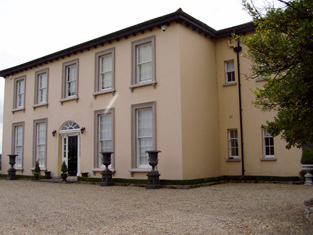
|
| Richmond | Located in the town of Fermoy, Richmond was occupied by H. Smyth in 1837 and by George Walker. It was the residence of the Furlong family in the second half of the 19th century. In the 1920s they sold the house to the Loreto Sisters. Still part of the convent complex at the beginning of the 21st century. |

|
| Ballinwillin | Lewis writes that this house was the occasional residence of the agent to Lord Kingston, reputedly built by Arthur Young who came to Mitchelstown in the 1770s as a land agent. In the mid 19th century Neale Brown was the occupant holding the house valued at £22.15 shillings and 13 acres from the Earl of Kingston. This house is still a well maintained residence. |

|
| Mitchelstown Castle | The original castle belonged to the FitzGibbons, the White Knight. It passed through the marriage of Margaret FitzGibbon and Sir William Fenton to the heirs of their daughter, Catherine, and her husband, Sir John King. By the mid 18th century the Kings had replaced the castle by a house which was altered and extended over the years. In 1786 Wilson refers to it as "the very magnificent seat of Lord Kingsborough". In the 1820s the 3rd Earl built a new castle in anticipation of a visit from George IV which never happened. This was a huge building in the Gothic Revival style, valued at £180 in the mid 19th century. It remained in the possession of the Kings until the death of Lady Kingston, widow of the 5th Earl. In 1922 the castle was looted and burnt and the stones were later used to build a church at Mount Melleray. In 1943 the Irish Tourist Association Survey provided a detailed description of the castle and its history and noted that portion of the cellars and foundations were still visible. |

|
| Marshalstown | This house was known as Castle Eugene in 1837 when it was the home of Eugene O'Neill, medical doctor. Dr O'Neill was still resident in the early 1850s when the house was valued at £41.10 shillings and held from the Earl of Kingston. This house no longer exists. | |
| Kilbarry (Castlelyons) | Hajba writes that a new house was built here in 1842 by the Wigmores. Robert Wigmore was resident in 1814, E[dward] Wigmore in 1837 and Henry Wigmore in the early 1850s when the buildings were valued at £23 and held in fee. In 1786, Wilson states that it was the residence of Hon. Mr. Moore. Later the home of the Kent and Waters families. Still extant and occupied. |

|
| Ballyglass/Ballyclough House | At the time of Griffith's Valuation Michael Cagney owned a house in the townland of Kilmagner valued at £24. Ballyglass House is marked on the first Ordnance Survey map in this townland. but the house at this location is named Ballyclough House on the 25-inch Ordnance map of the 1890s. Hajba identifies this house as Ballyclough House, Currabeha. Ballyclough was the residence of E. Creed in 1837. A house still exists at this location. | |
| Bellevue | Hajba writes that William Glissan sold this property to Thomas Dennehy of Clashmore, county Waterford. Bellevue was the home of Thomas Denehy in the first half of the 19th century, inhabited by him in 1814 and 1837 and by Daniel O'Neill in the early 1850s who held it from Thomas Denehy. The house was valued at £35. Later the home of the Dunleas, now a ruin. |
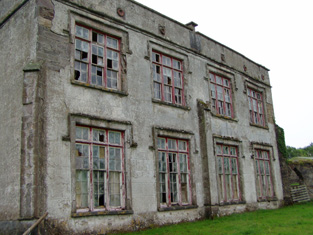
|
| Brook Lodge | The Lord Chancellor is given as the occupier of this house at the time of Griffith's Valuation. The Court of Chancery may have held the property from John Denehy at this time. The buildings were valued at £13. In 1942 the Irish Tourist Association Survey notes that it was once the residence of General Sir Thomas Dennehy and was then owned and occupied by James Scannell. A new house is now located on the site. | |
| Bettyville | The home of the Nason family in the early 19th century, occupied by Richard Nason in 1814 and 1837. By the early 1850s William Corbin was resident holding the house valued at £14.10 shillings from the representatives of Richard Nason. William Corbin was still living at Bettyville in the 1870s. This house is no longer in existence. | |
| Maryville | The home of Laurence Corban in 1837 when Lewis records it as “ a handsome mansion of recent erection and finely situated on the Funcheon [River]”. Laurence Corban held Maryville House and the mills in perpetuity at the time of Griffith's Valuation. The house was valued at £32 and the mills complex at £160. The Lucas family succeeded to this property and Hajba writes that it became the dower house for nearby Ballynacarriga. The Irish Tourist Association surveyor in the 1940s reported that it was then occupied by Mr. Glass, an agricultural instructor. In 1965 the house was sold by the Corban Lucas family. It remains a family residence. | |
| Rath-healy | In 1786 Wilson refers to Rath-hely as the seat of Mr. Bryan. It was the home of Arthur Hyde Lucas and his son and namesake in the 19th century. Arthur Hyde Lucas is recorded as occupier at the time of Griffith's Valuation, holding the property from John Hyde when it was valued at £20. In 1880 the property passed to Henry John Lucas, nephew of the second Arthur Hyde Lucas. Sold by the Lucas family in the 1920s and still inhabited. | |
| Ballynacarriga | A mid 18th century house, home of the Pyne family for over a century until they sold it in the Encumbered Estates' Court in 1852. Before the sale John G. Pyne was resident, holding the property in perpetuity. The buildings were valued at £18.10 shillings. Bought by Laurence Corban it passed from the Pynes to the Corban Lucas family, members of whom were still resident at the beginning of the 21st century. |

|
| Mounteagle Cottage | Hajba writes that this was a sporting lodge of the Earls of Kingston. In the early 1850s it was occupied by Thomas O'Brien and valued at £14.10 shillings. It is still a residence. | |
| Careysville | Careysville Castle, originally known as Ballymacpatrick Castle, was the seat of the Carey family from the late 17th century. In 1750 Careysville was occupied by John Carey and Peter Carey was resident in 1814. In 1837 Lewis refers to “the handsome modern mansion built on the site of Careysville castle” by E.K. Carey. Valued at £50 in the mid 19th century the Careys held this property in fee. Inherited by the Montgomerys of Killee and sold by them to the Duke of Devonshire in the mid 20th century. In 1942 the Irish Tourist Association Survey noted that the house was then unoccupied as Captain Montgomery had moved into a modern bungalow nearby. Careysville is now in use as a fishing lodge offering luxury accommodation. |

|
| Moorepark | A large Georgian house, the seat of the Earls of Mountcashell, extended in the 19th century. In 1786 Wilson describes it as "a superb and noble seat". It was held in fee at the time of Griffith's Valuation when it was valued at £87. Bought by the War Department in 1903 and accidentally burnt in 1908. In 1944 the Irish Tourist Association Survey noted that the remains of the kitchen were still visible then. Nothing remains of the original house and the site now belongs to Teagasc, the Agricultural and Food Development Authority. | |
| Glandulane House | Robert Briscoe had a house and flour mill in the townland of Clondulane North in the mid 19th century, which he held from the Earl of Mountcashel. The house was valued at £25.10 shillings and a flour mill at £96. Later the home of the Hallinans and the O'Donnells. A house is still extant at the site but the mill buildings are now ruinous. |

|
| Licklash | Occupied by James Reid in the early 1850s and held from the representatives of Matthew Hendly, the buildings were valued at £18. This house later became a summer home of Sir Oswald Mosley. Also known as Isleclash/Ileclash House. This house was offered for sale in 2010. http://www.michaelhdaniels.com/index.cfm?fuseaction=propdetails&Prop_RefId=24 |
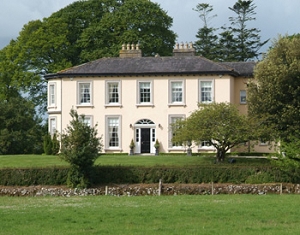
|
| Mountrivers | This house was a Hendley home in the 18th and 19th centuries, occupied by Mathers Hendley in 1814 and Mattias Hendley in 1837. Mattias C. Hendley was resident in the early 1850s. He held the property in fee and the buildings were valued at £27. The Hendleys contined to reside at Mountrivers until the 1930s and the house is still occupied. |
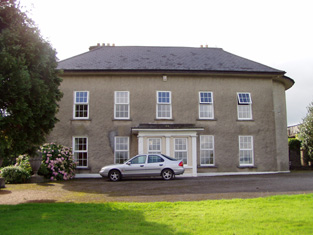
|
| Killee | The seat of the Montgomery family from the mid 18th century, occupied by George Montgomery in 1814 and by William Quinn Montgomery in the early 1850s. It was held in fee at this time and valued at £43. Killee remained in Montgomery possession until the 1930s. It is still occupied. |

|
| Grange Hill/The Grange | William Forward Austin was resident at Grange Hill in 1837 and in the early 1850s when he held the house valued at £41 in fee. Hajba writes that this property belonged to William Forward and was inherited by one of his daughters who was married to William Austin. William F. Austin was their son. Later the home of the Sadliers [1906] and Magniers, still inhabited. William Sadleir medical doctor was resident from circa 1866. |
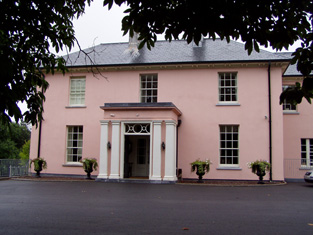
|
| Ashfield House | Occupied by John William Anderson in 1837 and by Denis Downing in the early 1850s who held the property from John Hyde. It was valued at £25. In 1942 the Irish Tourist Association Survey indicated that it was then the residence of William Bowden. This house is still occupied. | |
| Grange Farm | Originally part of the Forward estate which passed to Garret Nagle who had married the sister of William Forward. Marked on the first Ordnance Survey map as a farm yard by the 1850s James Roderick O'Flanagan was resident in a house valued at £13.5 shillings. He held the property from the representatives of John William Anderson. |

|
| Fermoy House | Lewis refers to Fermoy House in 1837 as the residence of the late J. Anderson “to whom not only the town owes its prosperity but the entire country…”. It was then occupied by Mrs Hennis. The Reverend Maurice Collis was in residence by the time of Griffith's Valuation. He held the property from Sir Robert Abercrombie and the buildings were valued at over £50. In 1786 Wilson writes of a house at Fermoy, the seat of Mr. Bryan. The Irish Tourist Association Survey of 1942 states that Fermoy House was then the property of Maurice Cooke Collis and was divided into five flats. The house was demolished in the 1960s. | |
| Rushmount | Located on the Mountcashell estate this house was occupied by Daniel Gearan in the early 1850s, when it was valued at £19. It remained in the possession of the Gearan/O'Geran family for the rest of the 19th century. |
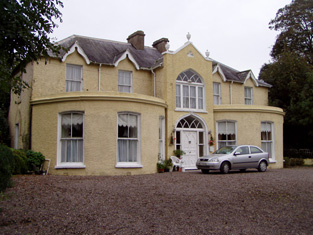
|
| Woodview | Occupied by Lieutenant F.Prangnall RN in 1837 and held by the Earl of Mountcashel in fee at the time of Griffith's Valuation when it was valued at £16. 5 shillings. Later occupied by the Smithwick and by the Lucas family in the 20th century until a fire in the 1930s. Recently restored and occupied again. | |
| Glansheskin | Occupied by John P. Pierse in the mid 19th century. He held the property valued at £19+ from the Earl of Mountcashel with a cornmill valued at £20. Later the property of the Cooke Collis family, this house is still occupied. | |
| Broomhill | Valued at £11, occupied by James Geran and held from James N. Cronin at the time of Griffith's Valuation. Later the home of a member of the Montgomery family and still inhabited. | |
| Cloonkilla | James H. Mandeville held buildings valued at £21 from James N. Cronin among the woods at Cloonkilla at the time of Griffith's Valuation. | |
| Park House | Hajba writes that David Richard Pigot, Chief Baron of Ireland 1846-1873, was born at Park House in 1797. He was the son of Dr John Pigot and Margaret Nagle and married Catherine Paye [Page in DNB] of the nearby Araglin Mills. Th house was valued at £7.10 shillings in the early 1850s and was occupied by the Reverend James Daly, who held it from William Byrne. The Pigotts continued to own this property until at least the late 19th century. Occupied by the Howard family in the 20th century. The Irish Tourist Association Survey notes that it was also referred to as "Rock House". The survey also refers to another house owned by the Pigot family on the main street in Kilworth. | |
| Moydilliga/Modeligo | In the mid 19th century this house was the home of Henry Braddell. It was valued at £16 and held by him in perpetuity. Wilson, writing in 1786, refers to it as the seat of Mr. Armstead. By 1906 the mansion house at Moydilliga was valued at £42 and occupied by Henry Braddell. In the early 20th century the property passed to the Haskins-Braddells. Sold by them in 1950, this house is still a family home. |
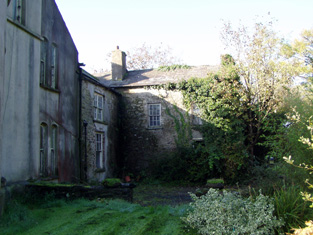
|
| Kilmurry | The house was built in the early 18th century and remained in the hands of the Grant family until sold to the Rosminian Order in the 1930s. In the 1940s the Irish Tourist Association surveyor was given to understand that the Grants still retained title to the property and were residing in South Africa. In the mid 19th century it was valued at £37 and held by Thomas St John Grant in fee. At the beginning of the 21st century this house was in a dilapidated state. |
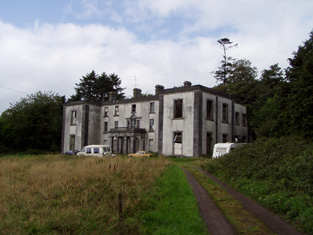
|
| Knockatrasnane | At the time of Griffith's Valuaiton, William Collis held in fee a house and offices valued at £14.10 shillings in this townland. The 1st edition Ordnance Survey map indicates a nursery at this site. The remains of the buildings are still extant. | |
| Castle Cooke | A house was located here from the 17th century. Originally home of the Cooke family it was altered and expanded in the succeeding centuries by the Collis family. William Collis was resident for much of the 19th century. The house was valued at £32 in the early 1850s and at £34 when occupied by Colonel William Cooke Collis in 1906. It was burnt in June 1921 during the War of Independence when it was the residence of Col. William Cooke-Collis. This house is no longer extant. | |
| Leitrim | Home of the Campion family for two centuries, sold by them in the 1870s to Major Victor Reeves of the Castle Kevin family. In 1943 the Irish Tourist Association Survey referred to it as the residence of David Nunan, formerly owned by the Campions, "in their day the house was thatched and much smaller". This 17th century house is still a residence. |

|
| Marshtown/Marston | Home of Richard Henry Gumbleton in the early 19th century and at the time of Griffith's Valuation when the buildings were valued at £12. 10 shillings. Advertised for sale in June 1854. Hajba writes that the Orpens built a much large house on the demesne in the 1860s which was burnt some time later. In 1906 Basil Orpin occupied a house valued at £55 at Marshtown. Buildings still exist at this site. An earlier Marshtown House, previous home of the Gumbletons, was located over the border in county Waterford. | |
| Araglin Cottage | Located on the bank of the Araglin River and built for Robert Viscount Kingsborough, later 4th Earl of Kingston, this was probably the summer residence recently erected by the Honourable Robert King in the parish of Templemologga, referred to by Lewis in 1837. It was offered for sale in July 1851 with 3,951 acres held by the Earl in the barony of Condons and Clangibbon. Sold to the Morlands who leased it as a fishing lodge, this house is now a family home. In the 1870s John Sherlock of Aroglin Cottage, Kilworth, was recorded as the owner of 183 acres in county Cork. |

|
| Ballyvolane | Hajba writes that Ballyvolane was bought by Sir Richard Pyne of Waterpark, Lord Chief Justice of Ireland, from the Coppingers in the early 18th century. It remained in the possession of the Pyne family until the mid 20th century and is still occcupied. Valued at £44 at the time of Griffith's Valuation, the house was occupied by Jasper Pine who held it from Thomas, George and Henry Walker. By 1906 the mansion house at Ballyvolane was valued at £70+ and occupied by George M.Pyne. |

|
| Ballyrobert | Hajba writes that Michael Mackay built a house beside the ruined castle of Ballyrobert in the 1820s and he is recorded as resident there by Lewis in 1837. In the early 1850s the house was valued at £23, occupied by Michael Mackay and held from John Peard. Michael J. Mackey occupied the house in 1906. This house no longer exists. | |
| Coole Abbey | This house was the home of a branch of the Peard family until the early 20th century and is still inhabited. It was occupied by Richard Peard in 1814 and by Henry Hawk Peard in 1837. He was still resident in the early 1850s and held the house valued at £36 from James H. Smith Barry. By the end of the 19th century Orr McCausland was the owner of Coole Abbey. |
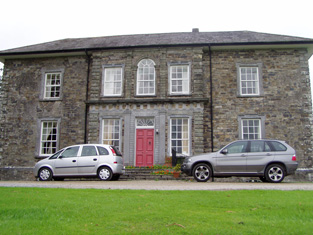
|
| Belvidere | This house was unoccupied in 1814. Mrs Maria Peard was the occupier in the mid 19th century holding the property from Henry Peard, it was valued at £15.12 shillings. Hajba writes that the Peards sold the estate to the Pope family who occupied the house until the early 20th century. |
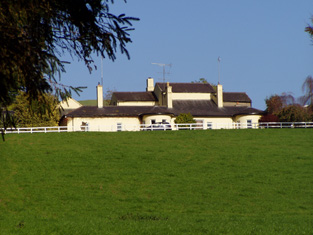
|
| Carrigeen Hall | In 1786, Wilson refers to "Carrygeen" as the seat of Mr. Peard. Hajba writes that this house was the home of Peard Harrison Peard, son of Richard Peard of Coole Abbey and father of Richard Frederick Peard of Belvidere and Henry Peard of Carrigeen. Later the home of the Green and O'Grady families, now demolished. | |
| Sun Lodge | Sun Lodge is marked on the first Ordnance Survey map and was occupied by Denis Hanan in the mid 19th century and held from Henry Peard. It was valued at £30+. Hanan's interest was advertised for sale in 1870. Hajba records various other occupants and this house is still occupied and well maintained. |

|
| Castleview | Castleview was the home of the Gumbleton family held from Henry Peard in the mid 19th century and valued at £68.15 shillings. The house remained in Gumbleton possession until the early 20th century but is now demolished. Bence Jones lists this house under the name Glynnatore and writes that it was built in 1791 by R. W. Gumbleton. In 1894 Slater notes Glenatore as the seat of Mrs. Gumbleton. | |
| Waterpark | Originally a Pyne residence which later passed through marriage to the Cavendishes. In 1786 Wlson refers to "the ruins of Water Park, the seat of the late Lord Chief Justice Pine". Hajba writes that other occupants were the Watkins and Drew families. There was no house of more than £2.10 shillings valuation in this townland, held by George Walker, at the time of Griffith's Valuation. | |
| Kilcor Castle | The home of the O'Brien family in the 18th and 19th centuries, sold by them in the mid 19th century. Cornelius O'Brien was the occupant in 1837 and at the time of Griffith's Valuation. He held the house valued at £17.15 shillings from James Reid. Kilcor was bought by Francis Doyne Dwyer and later passed to the Phipps family through marriage. In the 1940s the Irish Tourist Association Survey reported that it was the residence of Captain H. Phipps. |
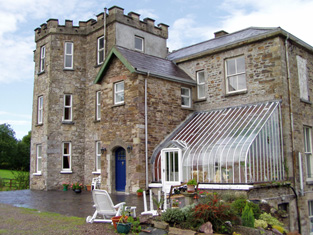
|
| Mohera | Hajba writes that Michael Mackay was recorded as resident here in 1824. By 1837 John O'Sullivan was resident and was still the occupier at the time of Griffith's Valuation. The buildings were then valued at £14 and the property was held from Major General Conyers. Home of the McAuliffes in the 20th century. |

|
| Rathbarry Cottage | Rathbarry Cottage was occupied by Major William Love Peard at the time of Griffith's Valuation. The property was held from the Reverend R. Gumbleton and the buildings were valued at £11. Some ruined walls remain at the site. | |
| Towermore | The home of Mrs Maria Oliver in 1837 but leased to Frederick C. Hayes in the early 1850s. The house was valued at £45. Maria was the widow of Charles S. Oliver of Inchera and a daughter of A. Morris of Dunkettle. A. Morris Oliver is recorded as a subscriber to Lewis ''Topographical Dictionary'' published in 1837 but is not mentioned in Burkes. Earlier, in 1786, Wilson refers to Tormore as the seat of Mr. Connor. This house was not occupied at the end of the 20th century although still extant. | |
| High Park | Occupied by the Reverend J. W. Edgar in 1837 and by Bridget Hogan in the mid 19th century, valued at £12+ and held from William Coppinger. This house no longer exists. | |
| Baneena | John Ross occupied a house at Baneena North valued at £11.10 shillings in the mid 19th century. He held the property from Abraham Devonsher. This house is not surrounded by a demesne on the first Ordnance Survey map. | |
| Mountain Lodge | Originally a shooting lodge of the Devonshers, it was the home of Abraham John Devonsher in the mid 19th century. He held the property valued at £3 in fee. It is now a ruin. | |
| Hollyhill | David Hallahan occupied Holy hill, Rathcormack, in 1814 and S. Croker in 1837. Eliza Croker held the property from Francis C. Reeves in the mid 19th century, when the buildings were valued at £11.10 shillings. [for this Croker family see http://members.iinet.net.au/~nickred/croker_research/The_Irish_CROKER.pdf page 121]. Later the home of the Campion and other families, this house is no longer extant. | |
| Ballyglissane | A Reeves home held from the Devonsher family, occupied by F.G. Reeves in 1837 and by Edward Reeves in the early 1850s when the buildings were valued at £30+. Later the home of the Warren family and still a family residence. |

|
| Mellefontstown | The main residence of the Nason family in the 18th century, John Nason was resident in 1814 and Pierce Cotter in the early 1850s. Cotter held the property from Thomas Wise and the buildings were valued at £19+. In May 1863 Pierce Joseph Cotter's estate at Mellifontstown, containing the house, demesne and 246 acres was advertised for sale. It was held on a lease dated 1852 from Francis Wise to Pierce Cotter for 185 years. A new house now stands on the site. | |
| Ballynahina | Ballynahina was a Barry home inhabited by Philip Barry and his wife Mary Ann at the end of the 18th century. Lewis refers to Gerard Barry at Ballinahina House and Reverend Dr Barry, Parish Priest of Fermoy for half a century, at Ballinahina Cottage. Edward Barry was resident at Ballynahina, valued at £11, in the early 1850s. He held the property from Gerald Barry. This house is still extant. |
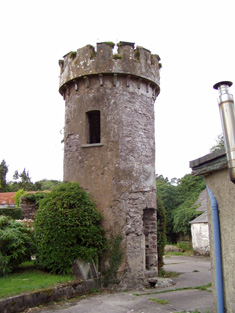
|
| Bride Villa | Hajba writes that this building was originally a coach inn. By the time of Griffith's Valuation Edward Barry a doctor was resident. He held the property valued at £14.15 shillings from Viscount Riversdale. This house is stil inhabited. |
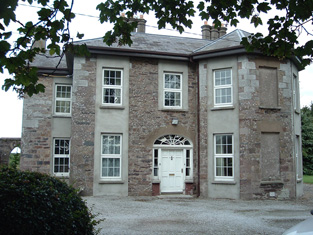
|
| Lisnagar | Originally a home of the MacAdam branch of the Barry family, sold to the Lawless brothers in the 1770s and soon afterwards bought by William Tonson. In 1786 Wilson refers to the seat of Lord Riversdale, close to Rathcormack. The house was occupied by the Reverend John Bolster in the early 1850s and valued at £39.15 shillings. Slater refers to it as the seat of W.A.S. Riversdale in 1894. William Alcock-Stawell succeeded to this property in 1861 and took the additional name of Riversdale. Lisnagar was sold in the early 20th century. This house is still a residence. |

|
| Kildinan | The home of Edward Roche father of the 1st Baron Fermoy in the late 18th and early 19th centuries. In 1837 Lewis refers to the "highly improved property" of Edmund Roche. By the time of Griffith's Valuation Kindinan valued at £32 was leased to William Dargan who also held a flax mill and 561 acres from the Roches. This house is still occupied. | |
| Terramount | A mid 19th century house, home of John G. Nason in the early 1850s. Held by him in fee and valued at £24.25 shillings. The Nasons owned this property until the early 20th century. The famous race horse Dawn Run was bred at Terramount in the 1970s. |
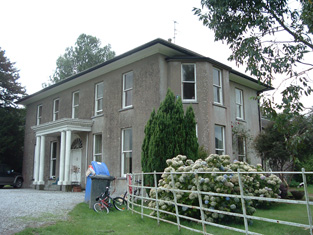
|
| Ballymacsimon | A house located on the Devonshire estate and occupied by John Kirby in the mid 19th century. The buildings were valued at £25. William Kirby held 2 townlands in the parish of Aghera at the time of Griffith's Valuation. Home of the Collins family in the mid 20th century and still inhabited. | |
| Bride Park | Hajba writes that the Reverend Stephen Rolleston built this house in the 1770s. In 1814 it was inhabited by the Reverend Spread and in the mid 19th century by Thomas Power who held it from Mrs Elina Greaves and others. The buildings were valued at £20+. Bride Park remained the home of the Power family until the early 20th century. This house has recently been renovated and restored. |

|
| Carrigmore | Richard Power was resident here in 1814 and Edward Morragh in the mid 19th century. Morragh held the property from the Duke of Devonshire and the buildings were valued at £18+. Later the home of the Cronin family. Hajba writes that this house has been unoccupied since 1990. | |
| Thornhill | A Nason home, first occupied by John William Washington Nason. His widow Mrs Barbara Nason is recorded as resident at the time of Griffith's Valuation. Valued at £18.11 shillings the house was held from the Duke of Devonshire. The Nason family continued to live here until the mid 20th century. The house is still an occupied residence. | |
| Killavarilly | At the time of Griffith's Valuation John O'Neill, a doctor, held a house valued at £25+ and 350 acres from the Duke of Devonshire at Killavarilly. A house is still located at this site. | |
| Mogeely House | A house on the Devonshire estate, occupied by Charles H. Walsh in the mid 19th century and valued at £25.18 shillings. Later the home of the Des Barres and Kent families. Slater refers to it as the seat of Lt-Col. Des Barres in 1894. Still a family residence. It is labelled Mogeely Castle on the 1st edition Ordnance Survey map but as Mogeely House on the later editions, |
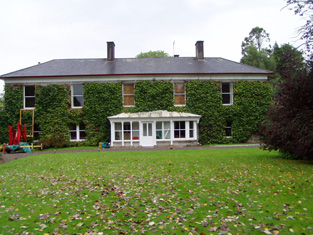
|
| Frankfort | This was a Woodley home, occupied by F. Woodley in 1837 and leased to Robert Wigmore in the early 1850s when the house was valued at £20+. The house was occupied until the 1970s but is now a ruin. |

|
| Ballinterry | Hajba writes that this property had passed from the Terrys to the Earls of Barrymore at the beginning of the 18th century. In 1814 it was the residence of the Reverend John Ross and in 1837 of Archdeacon Ryder. The Archdeacon was still resident at the time of Griffith's Valuation when the buildings were valued at £21. It now operates as a luxury guesthouse. |

|
| Castlelyons House | Situated on 2 acres in the centre of the town of Castlelyons this house was in the possession of the related clerical families of Browne and Ryder in the 18th and 19th centuries. Occupied by the Reverend Joshua B. Ryder in the mid 19th century. He held the property valued at £30 from Samuel Perrott. Still valued at £30 this house was occupied by the representatives of Andrew W. Ryder in 1906. |

|
| Berry Hill | The National Inventory of Architectural Heritage states that this house dating from circa 1700 was a dower house for the Barrymore family of Castlelyons Castle. By the mid 19th century it was in the possession of the Perrott family and occupied by the Reverend Philip Berry who held the buildings valued at £21 with 15 acres. This house is still occupied. |
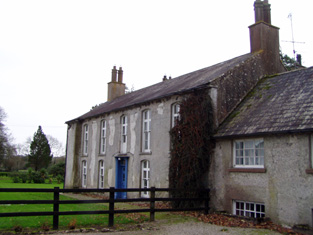
|
| Glenwood | Marked on the first Ordnance Survey map this house was occupied and held in fee by - Teulon at the time of Griffith's Valuation, when the buildings were valued at £23. By 1906 Glenwood valued at £33 was occupied by A. C. Fleury, a minor. In the 1940s the Irish Tourist Association survey noted that it was then the home of Mrs.Pennefather, "mother of the famous artist, who came to live here about twenty years ago". Glenwood is still extant. |
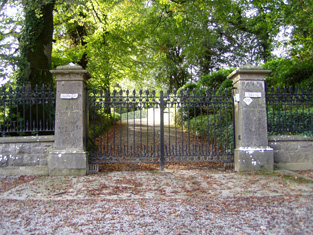
|
| Stannard's Grove | Located on the Cotter estate, this house was occupied by the Stannard family at the end of the 18th century. It was later occupied by the Adams and Smith families. Lewis records it as unoccupied and at the time of Griffith's Valuation it was held in fee by Edward Cotter. The home of William Stackpool at the beginning of the 20th century. Hajba writes that the house was reconstructed in 1924 after been blown up in 1921 by the British Crown Forces. In 1942 the Irish Tourist Association Survey noted that it had, since 1934, been owned by the Herlihy family. It is still extant. |

|
| Ballywilliam | Joshua Sutton lived at Ballywilliam in 1814. In 1851 the estate of William Parry Sutton, a minor, was offered for sale in the Encumbered Estates Court. It included interest in the lands of Shanrahan. The purchasers included Messers. Carroll, Greaves and Mooney, in trust. At the time of Griffith's Valuation, James King was resident, when the buildings were valued at £9.10 shillings and held from the Irish Land Company. |

|
| Ballygally House | Ballygally House was the property of Nelson T. Foley in 1851 when it was vacant and valued at £27 10s. In 1837 Lewis refers to it as "the occasional residence of G. Holmes Jackson". It is still extant and occupied. |

|
| Flowerhill House (Waterford) | Flowerhill was leased by Nelson T. Foley to Barry Drew in 1851. Lewis also refers to it as the seat of B. Drew, describing it as " a beautiful residence in the cottage style". The house is no longer extant. | |
| Elgin Cottage | In 1851 this property was leased by Georgiana Gumbleton to Edmund Barry when it was valued at £10. It was built after the 1st edition Ordnance map and is labelled Elgin Cottage on the 25-inch edition of the 1890s. There is still an extant house at the site. | |
| Marshtown House | Held in fee by R.H. Gumbleton at the time of Griffith's Valuation, when it was valued at £8 10s. The property is labelled Marshtown House on the 1st editon Ordnance Map but is not labelled on the later 25-inch edition. Marston House (W950987), in the adjacent townland of Marshtown, is shown on the 25-inch map of the 1890s but there is no trace remaining. | |
| Cloonbeg | A property described as offices, the property of R.H. Gumbleton, was valued at £15 5s at the time of Griffith's Valuation. In 1906 this property was owned by Basil Orpin with a valuation of £16. Some of the buildings still remain at the site. | |
| Ballyduff Castle Farm | Described as Ballyduff Castle (in ruins) on the 1st edition Ordnance Survey map, these buildings were valued at £11 15s at the time of Griffith's Valuation. They were being leased by Edward Walsh from the Musgrave estate. The National Inventory of Architectural Heritage suggests the house was built c.1825. The ruined fortified house at the site dates from the early seventeenth century. |
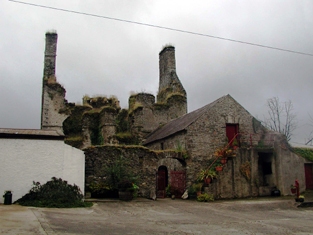
|
| Mocollop Castle | Mocollop Castle was in ruins by the time of Griffith's Valuation, though buildings at the site were valued at £31. They were held in fee by Captain James Barry. In 1786, Wilson refers to it as the seat of Dr. Drew. In 1906 the buildings at this location were in the possession of Henry Drew, MD, and valued at £32. The National Inventory of Architectural Heritage reports that the buildings there were in ruins in the early part of the 21st century. |

|
| Glenbeg House (Lismore) | In 1851 Glenbeg House was owned by Thomas Foley but was vacant. It was valued at £23 10s at that time. In 1837 Lewis refers to it as the seat of G. Bennett Jackson. The original house dates from the mid-sveenteenth century though it was renovated in the nineteenth and twentieth centuries. Smith, writing in 1774, refers to it as the seat of Mr. John Jackson. Sadleir, referring to Rowland Jackson in 1775, notes that he was "of Glanbeg". Brady notes that the Jacksons were employed by the first Earl of Cork in the early seventeenth century. Described as "an ordinary farmhouse" in the ITA Survey in 1942. It is still extant and occupied. |

|
| Ballybeg (Mitchelstown) | In 1786 Wilson states that "Ballybeg, the seat of Mr. Spratt, was pleasantly situated at the foot of a lofty mountain" outside Mitchelstown. Local history suggests that this was a property acquired by Devereux Spratt in the 17th century. It is not named on the 1st edition Ordnance survey map though buildings are shown at the site. | |
| Kilshanny | Wilson, writing in 1786, refers to Kilshanan as the seat of Captain King. An unnamed property is shown in the townland of Kilshanny on the 1st edition Ordnance Survey map which was later to be the site of Mitchelstown workhouse. It is no longer extant. | |
| Castle Lyons | Wilson, writing in 176, refers to the accidental burning of the seat of the Earls of Barrymore. "The mansion house, with the furniture and a valuable collection of pictures, were entirely destroyed by an accidental fire". Some ruins remain at the site. A dower house, built by the Barry family towards the end of the 18th century, is still extant and known as Berryhill. . |

